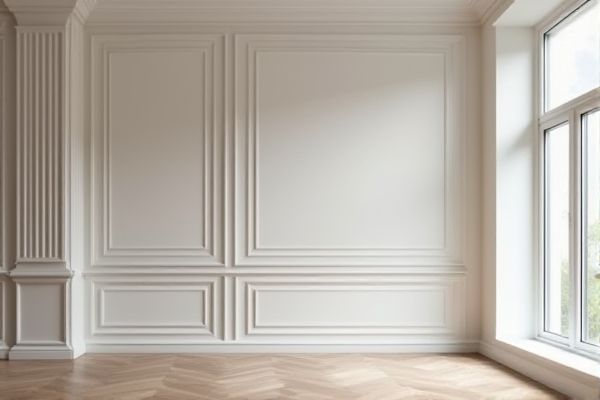
Fluted panels offer textured, vertical grooves that add depth and visual interest to surfaces, while flat panels provide a smooth, minimalist look ideal for modern spaces. Discover which panel style best suits your design preferences and functional needs by reading the full article.
Table of Comparison
| Feature | Fluted Panel | Flat Panel |
|---|---|---|
| Texture | Ribbed, grooved surface with vertical lines | Smooth, even surface without patterns |
| Aesthetic | Decorative, adds depth and visual interest | Minimalistic, clean and simple look |
| Material Usage | May require more material due to grooves | Uses less material, efficient design |
| Application | Common in modern, high-end interiors and acoustic designs | Versatile for any style, commonly used in cabinetry and walls |
| Maintenance | Can collect dust in grooves; needs careful cleaning | Easy to clean and maintain |
| Cost | Generally higher due to complexity | More cost-effective and widely available |
| Durability | Sturdy; grooves add structural texture but may chip | Durable with uniform surface, less prone to damage |
Introduction to Fluted Panels and Flat Panels
Fluted panels feature a series of narrow, vertical grooves that add texture and depth to walls, often used in modern and contemporary interior design for aesthetic enhancement. Flat panels present a smooth, even surface that emphasizes simplicity and minimalism, making them ideal for sleek, clean-lined spaces. Both panel types offer versatile applications in residential and commercial environments, allowing customization based on design preferences and spatial requirements.
Key Differences Between Fluted and Flat Panels
Fluted panels feature evenly spaced vertical grooves, creating a textured, three-dimensional surface that enhances visual depth and tactile interest, while flat panels offer a smooth, sleek finish with a minimalist aesthetic. Fluted panels often add architectural character and are used in modern and classical designs to emphasize shadow play and rhythm, whereas flat panels provide a clean backdrop ideal for contemporary interiors seeking simplicity and elegance. Installation and maintenance differ as fluted panels may require more careful cleaning due to grooves, contrasting with the easier upkeep of flat surfaces.
Design Aesthetics: Fluted vs Flat Panels
Fluted panels introduce a textured, vertical groove pattern that adds depth and visual interest, enhancing modern and sophisticated interior designs. Flat panels provide a smooth, minimalist surface, offering a clean and versatile backdrop that complements both contemporary and traditional aesthetics. Choosing between fluted and flat panels depends on whether the design prioritizes tactile complexity or understated simplicity.
Material Options for Each Panel Type
Fluted panels are commonly crafted from materials like MDF, wood veneer, and acoustic panels, offering texture and depth ideal for modern and contemporary interiors. Flat panels, on the other hand, provide a sleek surface typically available in materials such as plywood, laminate, and solid wood, making them versatile for various design aesthetics. Your choice between fluted and flat panels depends on the desired texture and finish, with material options directly influencing durability and overall style.
Installation Process: Fluted Panels vs Flat Panels
Fluted panels require precise alignment during installation to maintain their textured grooves, often necessitating specialized tools or techniques for accurate placement. Flat panels offer a more straightforward installation process due to their smooth, uniform surface, allowing for quicker mounting with standard tools. Both types demand proper surface preparation, but fluted panels generally take more time to ensure consistent spacing and visual appeal.
Durability and Maintenance Considerations
Fluted panels offer enhanced durability due to their grooved design, which provides additional strength and resistance to scratches compared to flat panels. Maintenance of fluted panels may require more attention as dust and dirt can accumulate in the grooves, while flat panels are generally easier to clean with smooth surfaces. Choosing between fluted and flat panels depends on balancing the desire for visual texture with practical upkeep needs.
Acoustic Performance Comparison
Fluted panels offer superior acoustic performance compared to flat panels due to their grooved surface, which effectively diffuses sound waves and reduces echo and reverberation in a room. Flat panels tend to reflect sound more directly, leading to increased noise levels and poorer sound quality. Your choice of fluted panels can significantly enhance sound clarity and create a more acoustically balanced environment.
Cost Analysis: Fluted Panels vs Flat Panels
Fluted panels typically incur higher costs due to the complexity of manufacturing and material usage compared to flat panels, which are generally more budget-friendly and straightforward to produce. The intricate grooves of fluted panels require additional labor and precision, increasing installation time and expenses. Flat panels offer a cost-effective solution for large-scale projects or minimalist designs, making them a preferred choice for budget-conscious constructions.
Popular Applications and Use Cases
Fluted panels are widely used in interior design for creating textured accent walls, wardrobe doors, and cabinetry, adding visual depth and modern sophistication to residential and commercial spaces. Flat panels are preferred for minimalist applications such as sleek kitchen cabinetry, wall cladding, and furniture surfaces, offering a smooth, clean appearance ideal for contemporary and industrial designs. Both panel types are utilized in retail displays and office partitions, with fluted panels emphasizing tactile detail and flat panels providing a streamlined, unobtrusive backdrop.
Which Panel Type is Best for Your Project?
Fluted panels offer textured depth and enhanced acoustic properties, making them ideal for contemporary designs and environments requiring noise reduction. Flat panels provide a smooth, minimalist finish that works well in modern, sleek interiors and allow for easy customization with paint or veneers. Choosing between fluted and flat panels depends on your project's aesthetic goals and functional needs, ensuring the panel type aligns with your design vision and performance requirements.
 homyna.com
homyna.com